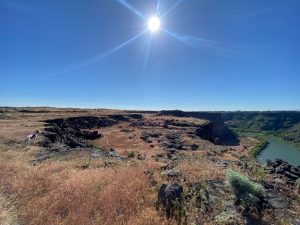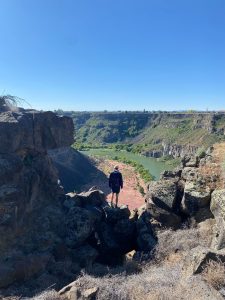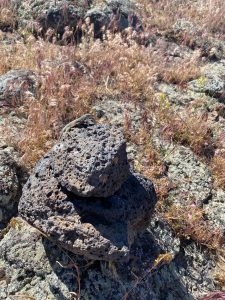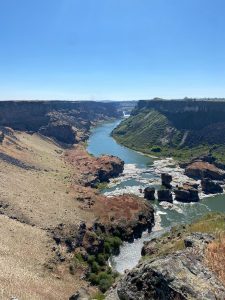No matter your relationship to Idaho, chances are you know—or have even seen—the spectacular cascade of Shoshone Falls on the Snake River. But have you ever seen these falls from the north side of the Snake River Canyon?
This May, ICL staff joined regional expert and Field Trip Chair of Prairie Falcon Audubon, Karl Ruprecht, for a hike along the north side of the Snake River Canyon near Twin Falls. Known as Snake River Canyons Park, a new trail system is slowly making a name for itself as a backyard recreation destination for the city of Twin Falls.

Starting at the light by Shoshone Falls Road, we wandered south toward the canyon rim where we watched a handful of signature Perrine Bridge base jumpers hurdle towards the water, quick to pull their parachutes and float to a makeshift airstrip alongside the water.

From Perrine Bridge, we followed thin, user-made trails east. Not unlike the river about almost 500 feet below us, the trails weave, wind, and eddy around the curves of rock; basalt buttresses form miniature walls and secluded zones for almost endless exploration. While we mostly stick to the track that leads upstream, sometimes we loop back downstream, or north away from the rim, or south to the edge of the canyon. In a few spots, we stop for the more adventurous members of the ICL staff to explore tunnels and steep boulder fields that allow passage to the river below. 
On the south rim, bikers and pedestrians wander up and down the pavement of the more well-known “Snake River Canyon Rim Trail,” as well as the entry points for Dierkes Lake and Shoshone Falls. They seemed largely unaware of the peaceful single-track trail some 1,600 feet opposite them to the north. With open range surrounding us, the small local wildlife and bird population are unfettered by our company. In addition to Western Fence and Common Side Blotched lizards, we see an impressive array of birds. Karl, our guide, estimated we’d seen over 15 different species, including American Kestrels, ravens, turkey vultures, and Prairie Falcons. The kestrels even give us a show, a male and female pair launching a midair attack on a passerby raven, who, presumably, cast a hungry eye just a little too long on the kestrels’ nest.
A little over halfway through our walk, we pass over Pillar Falls. The monoliths of stone are impressive in their own right from the level of the water; from above, they’re all the most spectacular. We watch the swirl of water over and around and over the great, top-heavy stones and chat about the Bonneville Flood.
Besides the ancient flood event that formed geology around us, we also cover some other fun regional trivia: like the fact that Evil Knievel did not, in fact, jump the canyon on a bike but a rocket, and that a split-second clip of the Snake River Canyon walls made it into Indiana Jones and the Temple of Doom. 
From Pillar Falls, we get our first view upstream toward Shoshone Falls. While many of us have seen the falls from the opposite rim (or even from the water), none of us had ever seen the falls from this angle before. The river bends gently between the two falls, bookended perfectly by the white spray of Shoshone to the east, at the far end of our view, and Pillar to the west, directly below us.
From Perrine Bridge to Shoshone Falls, it’s just under five miles; we arranged a shuttle on the access road, but for a longer walk, this trail can be run out-and-back. Once we’re peering almost directly over Shoshone Falls, that’s when we turn north towards the access road; a quick scramble over a rock wall brings us to our shuttle vehicle. It’s now midday and the sun is high in the sky; while we’ve enjoyed every minute of this walk, we’re glad to seek shade and make lunch plans.
We’re amazed to see that this backyard gem of the Twin Falls area is still something of a mystery, a secret. That said, soon the trails will become more accessible with the construction of a parking area on the northeast side of the Perrine Bridge. When planning your own adventure, here’s what to keep in mind:
- Don’t forget the sunscreen! There is no shade on this hike. It is also a good idea to bring ample water and plan around the weather.
- There’s no railings or barriers on this side of the canyon, just the incredible drop of the canyon. Always tread with care, and if you’re planning on bringing animals or children, keep a close eye on them!
- Give some extra time and attention to your shoes and socks when you get home. This area, unfortunately, suffers from widespread infestations of non-indigenous plant species. Stop the spread, clean your gear!
To learn more about Snake River Canyons Park, we recommend checking these trails out for yourself and help us get the word out about this budding trail system! For more information on Snake River adventures—and to be notified of opportunities to take action on behalf of our beloved Snake River—sign up for ICL Snake River Campaign email updates!
